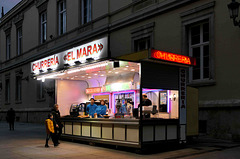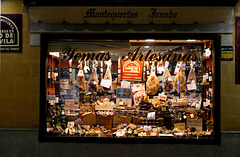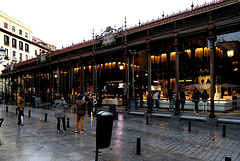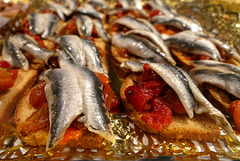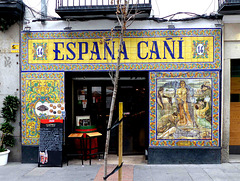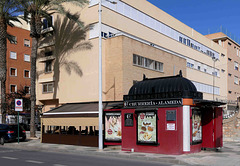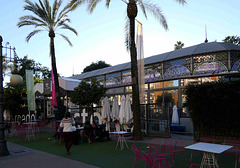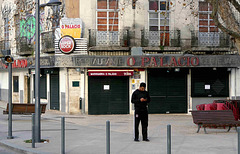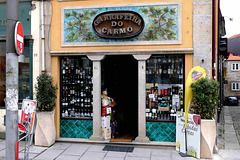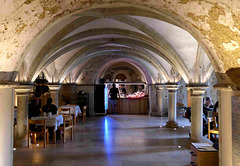
miam-miam
Restaurants, eateries, coffee-shops, take-aways, food and drinks!
Burgos - Taperia Bar Royal
| |
|
|
Spanish cuisine differs in many ways from the cuisines of France or Italy, which were more familiar to us. But it is exciting and sometimes very surprising.
With the small bites, which are called "pintxos" or "tapas", you can go to a wide sea of flavors, because the number of different bites is almost infinite.
Pulpo
Palencia - Churrería - "El Mara"
| |
|
|
Palencia was called Pallantia in ancient times and was the capital of a Celtiberian tribe. Palencia probably became the seat of a bishop as early as the 3rd century, and the city experienced its first heyday under the Visigoths in the 6th and 7th centuries.
In the 8th century, the Arab-Moorish armies conquered the area around Palencia. In the 11th century the city was reconquered by the Christians (reconquista). The greatest supporter at the beginning of the 13th century was the Castilian King Alfonso VIII. Already during his lifetime, but mainly after his death (1214), the existing cathedral school was converted into one of the first universities in Europe.
Churrería - "El Mara"
Ávila -Yemas Artesanas
| |
|
|
Under the Visigoths, Ávila was one of the most important cities in the kingdom due to its proximity to the capital Toledo. From the 8th to the 11th centuries, Ávila was Moorish. The situation in the contested borderland between the Muslim and Christian worlds prevented prosperity, which only began in the 15th century when the fighting moved further south. The city experienced its heyday in the 16th century. The plague, the expulsion of the Moriscos (baptized Moors), and the emigration of many people to America caused Ávila's gradual decline, from which the city has only slowly recovered since the 19th century. Today the population is around 60,000.
"Yemas de Avila" are a local speciality
Ávila - La Churreria
| |
|
|
Under the Visigoths, Ávila was one of the most important cities in the kingdom due to its proximity to the capital Toledo. From the 8th to the 11th centuries, Ávila was Moorish. The situation in the contested borderland between the Muslim and Christian worlds prevented prosperity, which only began in the 15th century when the fighting moved further south. The city experienced its heyday in the 16th century. The plague, the expulsion of the Moriscos (baptized Moors), and the emigration of many people to America caused Ávila's gradual decline, from which the city has only slowly recovered since the 19th century. Today the population is around 60,000.
Madrid - Mercado de San Miguel
| |
|
|
Madrid is the capital and most populous city of Spain. The city has almost 3.4 million inhabitants and a metropolitan area population of approximately 6.7 million. Madrid is part of the historical landscape of Castile and is located in the middle of the Meseta, the plateau of Castile.
The site of modern-day Madrid has been occupied since prehistoric times. The first document about the existence of an established settlement in Madrid dates from the Muslim age. In the second half of the 9th century Umayyad Emir Muhammad I built a fortress here. After the disintegration of the Caliphate of Córdoba in the early 11th century, Madrid was integrated into the Taifa of Toledo. In 1083, Madrid was conquered by the Kingdom of Castile. In 1309, under Fernando IV, the Assembly of Estates (Cortes) of the Kingdom of Castile was convened for the first time in Madrid.
In 1561, Philip II moved the royal court from Valladolid to Madrid. It became the de facto capital of Spain, which it remains to this day. In 1701 the War of the Spanish Succession broke out, which led to the Anglo-Portuguese occupation of the city in 1706. It ended in 1714 with the Bourbons taking over the Spanish throne. Today's royal palace was built under their rule. Particularly during the reign of Charles III, who is therefore popularly referred to as the “best mayor of Madrid”, the city's public infrastructure was modernized and numerous public buildings were built.
The covered market was originally built in 1916. It was purchased by private investors in 2003 who renovated the iron structure and reopened it in 2009. By now it is not a traditional grocery market any longer but a gourmet tapas market, loved by many tourists. Even champagne is offered.
Madrid - Mercado de San Miguel
| |
|
|
Madrid is the capital and most populous city of Spain. The city has almost 3.4 million inhabitants and a metropolitan area population of approximately 6.7 million. Madrid is part of the historical landscape of Castile and is located in the middle of the Meseta, the plateau of Castile.
The site of modern-day Madrid has been occupied since prehistoric times. The first document about the existence of an established settlement in Madrid dates from the Muslim age. In the second half of the 9th century Umayyad Emir Muhammad I built a fortress here. After the disintegration of the Caliphate of Córdoba in the early 11th century, Madrid was integrated into the Taifa of Toledo. In 1083, Madrid was conquered by the Kingdom of Castile. In 1309, under Fernando IV, the Assembly of Estates (Cortes) of the Kingdom of Castile was convened for the first time in Madrid.
In 1561, Philip II moved the royal court from Valladolid to Madrid. It became the de facto capital of Spain, which it remains to this day. In 1701 the War of the Spanish Succession broke out, which led to the Anglo-Portuguese occupation of the city in 1706. It ended in 1714 with the Bourbons taking over the Spanish throne. Today's royal palace was built under their rule. Particularly during the reign of Charles III, who is therefore popularly referred to as the “best mayor of Madrid”, the city's public infrastructure was modernized and numerous public buildings were built.
The covered market was originally built in 1916. It was purchased by private investors in 2003 who renovated the iron structure and reopened it in 2009. By now it is not a traditional grocery market any longer but a gourmet tapas market, loved by many tourists.
Freshly made Tapas
Madrid - Mercado de San Miguel
| |
|
|
|
Madrid is the capital and most populous city of Spain. The city has almost 3.4 million inhabitants and a metropolitan area population of approximately 6.7 million. Madrid is part of the historical landscape of Castile and is located in the middle of the Meseta, the plateau of Castile.
The site of modern-day Madrid has been occupied since prehistoric times. The first document about the existence of an established settlement in Madrid dates from the Muslim age. In the second half of the 9th century Umayyad Emir Muhammad I built a fortress here. After the disintegration of the Caliphate of Córdoba in the early 11th century, Madrid was integrated into the Taifa of Toledo. In 1083, Madrid was conquered by the Kingdom of Castile. In 1309, under Fernando IV, the Assembly of Estates (Cortes) of the Kingdom of Castile was convened for the first time in Madrid.
In 1561, Philip II moved the royal court from Valladolid to Madrid. It became the de facto capital of Spain, which it remains to this day. In 1701 the War of the Spanish Succession broke out, which led to the Anglo-Portuguese occupation of the city in 1706. It ended in 1714 with the Bourbons taking over the Spanish throne. Today's royal palace was built under their rule. Particularly during the reign of Charles III, who is therefore popularly referred to as the “best mayor of Madrid”, the city's public infrastructure was modernized and numerous public buildings were built.
The covered market was originally built in 1916. It was purchased by private investors in 2003 who renovated the iron structure and reopened it in 2009. By now it is not a traditional grocery market any longer but a gourmet tapas market, loved by many tourists.
Freshly made Tapas
Madrid - España Cañí
| |
|
|
Madrid is the capital and most populous city of Spain. The city has almost 3.4 million inhabitants and a metropolitan area population of approximately 6.7 million. Madrid is part of the historical landscape of Castile and is located in the middle of the Meseta, the plateau of Castile.
The site of modern-day Madrid has been occupied since prehistoric times. The first document about the existence of an established settlement in Madrid dates from the Muslim age. In the second half of the 9th century Umayyad Emir Muhammad I built a fortress here. After the disintegration of the Caliphate of Córdoba in the early 11th century, Madrid was integrated into the Taifa of Toledo. In 1083, Madrid was conquered by the Kingdom of Castile. In 1309, under Fernando IV, the Assembly of Estates (Cortes) of the Kingdom of Castile was convened for the first time in Madrid.
In 1561, Philip II moved the royal court from Valladolid to Madrid. It became the de facto capital of Spain, which it remains to this day. In 1701 the War of the Spanish Succession broke out, which led to the Anglo-Portuguese occupation of the city in 1706. It ended in 1714 with the Bourbons taking over the Spanish throne. Today's royal palace was built under their rule. Particularly during the reign of Charles III, who is therefore popularly referred to as the “best mayor of Madrid”, the city's public infrastructure was modernized and numerous public buildings were built.
A nice place for tapas
Cartagena - Churrería-Alameda
| |
|
|
The Iberian predecessor settlement of Cartagena was in 227 BC. naval and military base, de facto the capital of the Carthaginians on the Iberian Peninsula. From here Hannibal set off for Italy at the beginning of the Second Punic War (218 BC). The Romans conquered the city in 209 BC. BC and called it Carthago Nova. Carthago Nova was the most important silver mining region of the Roman Empire. According to Polybius, 40,000 people worked in the silver mines here.
It was destroyed by the Vandals in 425, was probably Visigothic in 475, and Byzantine in 554. Under the name Carthago Spartaria, it was the capital of the Eastern Roman province of Spania before it became Visigoth again in 625. From 711, after the fall of the Visigothic Empire, it became part of the Todmir Empire, and in 756 it became part of the Emirate of Córdoba. Conquered by King James I (Jaime el Conquistador) in 1269, it came to Aragon in the course of the Christian Reconquista, now called Cartagena.
Churrería-Alameda
Córdoba - Mercado Victoria
| |
|
|
Córdoba shares its history with many cities in Southern Spain. It was Carthaginian and Roman (from 260BC on), later it belonged to the Byzantine Empire for two decades, was looted by the Vandals before the Visigoths conquered it in 572. In 711 it was taken by the by the Umayyad army and became a provincial capital.
At that time a Christian church erected by the Visigoths was on the site, it was divided and shared by Muslims and Christians. In 784 the Christian half was purchased by Emir Abd al-Rahman I, who then demolished the church and started to build the grand mosque of Córdoba on its ground. The Mezquita reached its current dimensions in 987 with the completion of the outer naves and courtyard. It covers an area of more than 23.000 m².
But there is much more than the breathtaking Mezquita.
The old market hall was transferred into a gourmet food court
www.mercadovictoria.com
Sevilla - Taberna de Las Escobas
| |
|
|
Seville was a Roman "colonia" since 45 BC. The important city was looted by the Vandals in 428 and developed into a Bishopric seat under Visigothic rule. After the Moors had defeated the Visigoths in the Battle of Guadalete, they conquered Seville and made it the capital of a province. Normans devastated Seville in 844 but Seville was rebuilt and flourished under the different Moorish dynasties. In 1248 Seville was conquered by the troops of Ferdinand III of Castile. The emigration of thousands of Moors to Northern Africa led to a decrease in economics in the whole area. Seville recovered in the 16th and 17th century when it became the hub of Spanish maritime trade. During this period, the port of Seville had a monopoly on overseas trade. Vespucci and Magellan planned and started their voyages here. As a result of the War of the Spanish Succession, in 1717 Seville lost the transatlantic trade monopoly to Cádiz.
The "Antigua Taberna de Las Escobas" dates back to 1386, making it the oldest establishment in Spain. The oldest tavern in Spain is named after an old basket weaver, who made the brooms or "escobas" by hand.
People from all walks of life used to come to the Antigua Taberna de Las Escobas, including writers. It´s claimed that English poet Lord Byron, father of mathematician Ada Lovelace, was a guest here.
Lisboa - O Palácio
| |
|
The Phoenicians founded bases in Portugal from 1000 BC. They and later the c are said to have called the site "Alis Ubbo" and used it as the only large natural harbor on the Iberian Atlantic coast. According to Pliny the Elder, Lisbon was later regarded as a foundation of Odysseus.
Under Roman rule, from around 205 BC, the city was initially called Olisipo. Julius Caesar succeeded in breaking the last resistance of the local tribes in 60 BC. Under Caesar, Roman veterans were settled here to control the area. The town was granted Roman city rights in 48 BC and subsequently became a larg town in the province of Lusitania. From 409 A.D. onwards, barbarian tribes advanced into the Iberian Peninsula. Alans, Suebi, Vandals and Visigoths attempted to occupy Lisbon. In 468, the Roman city commander surrendered the city to the Suebi, but shortly after the earthquake of 472 the Visigoths began to rule.
In 719, Lisbon was conquered by Muslim Moors and later became part of the Emirate of Córdoba. After this, the city experienced its first major boom. Although Alfonso II conquered the city for a short time in 798,[ Lisbon soon fell to the Moors again. During the Caliphate of Córdoba, the city was one of the most important ports, while Christian Galicians and Leonese repeatedly attempted to conquer it. Vikings devastated the city and the surrounding area in 844.
In the 11th century, Lisbon belonged to the Emirate of Badajoz. From 1093, Raymond of Armous, a son of William I of Burgundy, was given the rule of Galicia. From there, he undertook campaigns against the Moors in the south. He succeeded in temporarily entering Lisbon after the Muslim ruler of Badajoz had submitted to King Alfonso, but even this conquest was was not permanent, nor was the occupation of Lisbon by Norwegian crusaders under Sigurd in 1108.
Even when Alfonso I came to power, the south of the Iberian Peninsula was still held by the Moors. However, in 1147, the siege of Lisbon finally led to the capture of the city. External support for the attackers was decisive: the successful siege of the city by an army of crusaders from the Second Crusade secured Alfonso I the basis for his rule over the entire surrounding area.
An earthquake struck on the morning of 1 November 1755.Along with a major fire and a tsunami, the Lisbon earthquake destroyed the Portuguese capital almost completely. With 30,000 to 100,000 deaths of the 275,000 inhabitants, this earthquake is one of the most devastating natural disasters in European history. About 85 percent of all Lisbon's buildings were destroyed.
O Palácio - most restaurants open very late and seem to sleep over the day.
Porto - Garrafeira do Carmo
| |
|
With around 250,000 inhabitants, Porto is the largest city in the north of Portugal. More than 1.7 million people live in the "Greater Porto area", the metropolitan region.
The historic centre of Porto was declared a UNESCO World Heritage Site in 1996. Port wine is named after Porto because the wineries of Vila Nova de Gaia on the south bank of the Douro River are the centres for packaging, transporting and exporting the fortified wine.
I have uploaded many photos from previous visits.
So I will limit myself and only upload a few.
In its own words, this is a "Cathdrale of port wine".
Rochester - Rochester Cathedral
| |
|
|
|
Rochester, today a town with a population of around 24,000, was founded by the Romans in 43 AD as a fortified town with a bridge over the Medway River.
The area had been inhabited by Romano-British, Jutes and Saxons since the Anglo-Saxon conquest in the middle of the 5th century. In 604, St Augustine of Canterbury sent Justus to build a cathedral near Rochester. The cathedral´s school, the King's School, still exists today. Rochester became the second episcopal see on the British Isles after Canterbury.
In 676, Rochester was sacked by Æthelred of Mercia. In the Viking Age, the city was sacked by the Danes in 842 and 884. In 877, Alfred of Wessex ordered ships to be built to fight the Danes. This heralded the era of shipbuilding in the towns on the Medway. In 930, Rochester was granted the right to mint coins. Around 1100 Bishop Gundulf began building the new Rochester Cathedral on the remains of the former cathedral. The cathedral was completed in 1130. In 1215, the city was conquered by John, King of England (John Lackland) and attacked by Simon V de Montfort in 1264.
The cathedral's founder and first bishop was Justus, one of the missionaries sent to England by Pope Gregory I at the request of St Augustine of Canterbury in 601.
After the Norman conquest of England, Bishop Gundulf, a Benedictine from Le Bec Abbey, had a Benedictine monastery built next to the cathedral and the cathedral itself was rebuilt. The consecration took place in 1130 in the presence of King Henry I. The nave and west façade as well as parts of the crypt have been preserved from this construction.
A fire damaged the cathedral in 1137, and reconstruction began in 1180 with the construction of the Gothic choir, which surpassed the nave in size.
The veneration of William of Perth, who, according to local tradition, was slain by his foster son as a pilgrim to Jerusalem near Rochester in 1201 and canonised by Pope Alexander IV in 1256, brought pilgrims to the cathedral, enabling the Gothic building project to continue. The new choir was consecrated in 1227 and the northern and southern transepts were built in the following decades. Bishop Hamo Hythe had them vaulted and the mighty crossing tower erected. One hundred years later, the current clerestory of the nave and the western façade window were built.
With the English Reformation, the Benedictine monastery of St Andrew was dissolved and the cathedral was given a new, Protestant cathedral chapter.
Extensive restoration work was carried out in 1825 and 1872. The crossing tower was renovated in 1904.
Cafés in or under churches and cathedrals were a surprise for me
Chichester - St Peter the Great / Duke & Rye
| |
|
|
Chichester was a Roman and Anglo-Saxon settlement and a major market town from those times through Norman and medieval times.
In the 9th century Alfred the Great set about building a system of fortified towns or forts in response to the Viking threat. This included old Roman settlements where the walls could be rebuilt and strengthened. Chichester was one of these and was rebuilt probably between 878–879.
Following the Norman conquest, the cathedral that had been founded in 681 at Selsey was moved to Chichester. When the Domesday Book was compiled, Cicestre comprised 300 dwellings which held a population of 1,500 people. After the Battle of Hastings the township of Chichester was handed to Roger de Mongomerie, 1st Earl of Shrewsbury, for courageous efforts in the battle. Shortly after 1066 Chichester Castle was built by Roger de Mongomerie to consolidate Norman power. In around 1143 the title Earl of Arundel was created and became the dominant local landowner. In 1216, Chichester Castle was captured by the French, but regained the following year.
St Peter the Great is another neo-Gothic building that appears to be older than it is. It was only completed in 1852. Due to the dwindling congregation and the cost of necessary repairs, the church was deconsecrated in 1982.
The building now houses the Duke & Rye pub.
www.dukeryechichester.co.uk
Jump to top
RSS feed- Latest items - Subscribe to the latest items added to this album
- ipernity © 2007-2024
- Help & Contact
|
Club news
|
About ipernity
|
History |
ipernity Club & Prices |
Guide of good conduct
Donate | Group guidelines | Privacy policy | Terms of use | Statutes | In memoria -
Facebook
Twitter


